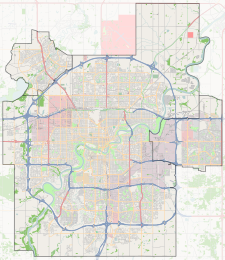Mazankowski_Alberta_Heart_Institute
University of Alberta Hospital
Hospital in Edmonton, Alberta
The University of Alberta Hospital (UAH) is a research and teaching hospital in Edmonton, Alberta, Canada. The hospital is affiliated with the University of Alberta and run by Alberta Health Services, the health authority for Alberta. It is one of Canada's leading health sciences centres, providing a comprehensive range of diagnostic and treatment services to inpatients and outpatients. The UAH treats over 700,000 patients annually.[1]
This article needs additional citations for verification. (November 2012) |
The University of Alberta Hospital, Mazankowski Alberta Heart Institute and the Stollery Children's Hospital co-reside within the large Walter C. Mackenzie Health Sciences Centre (WMC) and act as embedded "hospitals within a hospital." With 650,[2] 146[3] and 89[4] inpatient beds in the three hospitals, respectively, WMC has an estimated total of 885 beds. Combined, this makes the Walter C. Mackenzie Health Sciences Centre one of the largest hospitals in Western Canada, exceeding the Royal Alexandra Hospital's 869 beds, but behind Calgary's Foothills Medical Centre.[5][6] The Mazankowski Alberta Heart Institute is located in a new expansion to the WMC that opened on May 1, 2008.[7][8]
Because of UAH, the surrounding area has become part of a healthcare cluster that also includes the Cross Cancer Institute, the Heritage Medical Research Building, the Zeidler Ledcor Center, the Katz Group/Rexall Center for Pharmacy and Health Research, the Kaye Edmonton Clinic, and the Edmonton Clinic Health Academy.
The whole complex is served by the Health Sciences/Jubilee light rail transit station and the University station.

